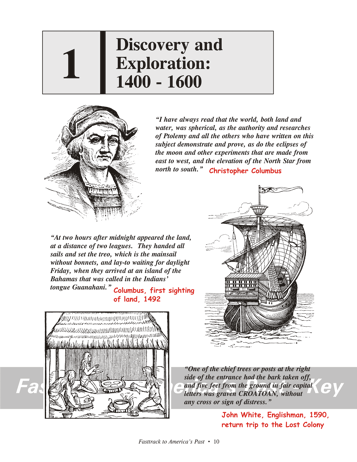| Fasttrack
to America's Past Teacher Key |
|
| Fasttrack
to America's Past Teacher Key |
|
 Page 10 |
Page 10 -
Section 1 Title Page The pictures Engage students as you begin the unit by asking them what
they think each picture on the title page is showing. Give hints,
encourage thoughtful speculation, and work in some of these interesting
facts: 1.
An artist's depiction of Christopher Columbus, based on a painting made
well after the death of the explorer. No images of Columbus made
in his own lifetime are known to exist. Many details of his life
and voyages, however, did survive into the written record of history. 3. A drawing made by an early explorer showing natives in the West Indies making corn pancakes, or what today would be called tortillas. Corn was completely unknown to Europeans before they made contact with the New World in 1492. The famous quotes Working in pairs or small groups, have
students read the quotes and share ideas with each other about the
possible source. If computers are available, have them research
each quote's source by entering a short phrase from each in a search
engine. Students should identify them with short notes right on
the page, and be able to explain their importance in history.
Some background on each quote is given below.
This passage is from a letter written by
Christopher Columbus.
It proves that he was well aware that the earth is shaped like a
sphere,
and that he could give several ways to prove the fact. Ptolemy
was
a famous Greek geographer and astronomer of the 2nd century A.D. who
had
written about the spherical shape of the earth. In a lunar
eclipse,
the shadow thrown by the earth onto the moon is always curved.
That
is only possible if the earth is a globe. The elevation of the
North
Star above the horizon changes with movement of the observer north and
south, again, something that is only possible if the earth is a
globe.
The other "experiments" Columbus mentions may be the fact that a ship
sailing
out to sea seems to vanish as it moves over the curved surface of the
globe.
This is a passage from the journal Columbus
kept
on his
voyage in 1492. It describes the first sighting of land in the
New
World on October 12 of that famous year. The actual island of his
first landing is uncertain. 3. "One of the chief trees or posts at the right side of the entrance..." This is from the account by John White describing the search in 1590 of the area where the Lost Colony was established by the English. The colonists had been left on Roanoke Island in what is now North Carolina in 1587. White went back to England to get more supplies shortly after that. His return to the colony was delayed for three years because of an attempt by Spain to attack England. All English ships were needed for defense against the Spanish ships. When White finally made it back, the colonists were gone. He spotted the word "Croatoan" carved on a tree, a message White believed meant the colonists moved to that area of what is now called Hatteras Island. (See pages 26 and 27.) |
|
Copyright Notice
Copyright 2018 by David Burns. All rights reserved. Illustrations and reading selections appearing in this work are taken from sources in the public domain and from private collections used by permission. Sources include: the Dover Pictorial Archive, the Library of Congress, The National Archives, The Hart Publishing Co., Corel Corporation and its licensors, Nova Development Corporation and its licensors, and others. Maps were created or adapted by the author using reference maps from the United States Geological Survey and Cartesia Software. Please see the home page for this title for more information. |